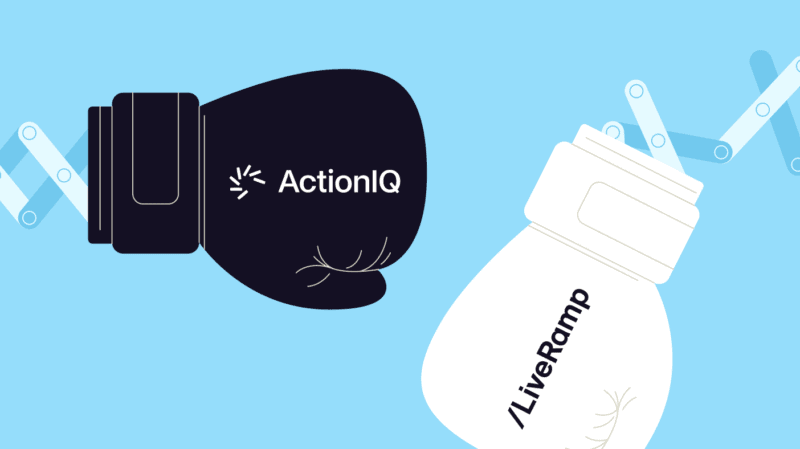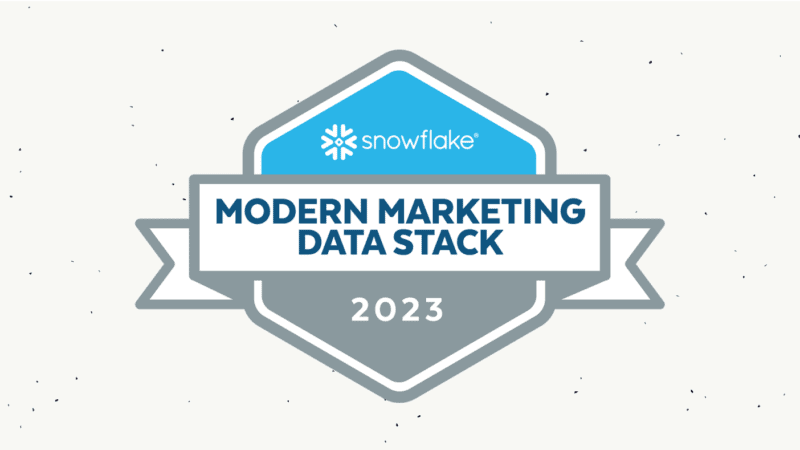Democratize Data to Boost Business and Scale Results

What does it mean to “democratize data”? Data democratization is a fancy way of describing something simple: putting valuable data insights into the hands of the people who can do something about them (usually business teams, such as marketing, sales and customer service).
Because it’s the technical teams that have the knowhow for gathering and sifting through customer data, business teams consisting of non-technical professionals must often rely on their technical peers to access and leverage this information.
As a result, technical teams become the data gatekeepers, unintentionally slowing down the efficiency of business teams that need customer data to spot opportunities and make decisions on an ongoing basis. In turn, business teams continually take up their technical peers’ time by requesting customer data, thereby slowing down the higher-impact projects of IT and data science departments (such as refining data security and operationalizing data models).
There’s a better way. Data democratization is about empowering both technical teams and business teams. And its foundation is self-service analytics, which enables everyone — regardless of technical knowledge — to gather and filter data for use without a bottleneck.
In this blog post, we’ll cover the challenges and benefits of data democratization, as well as data literacy, self-service and how to actually democratize data in your own organization using a customer data platform (CDP).
Learn how Pandora Media democratized its data in the video below:
Democratize Data to Boost Business and Scale Results
Data Democratization Requires Data Literacy
Providing access to customer data won’t do organizations much good if everyday users are unable to make heads or tails of it. This is why tools that support data literacy are crucial to data democratization.
Data literacy is the ability to not only access, but also comprehend and leverage data as actionable information. Customer data can include purchase history, device usage, cross-channel engagement behaviors, geographic location, average order value (AOV), customer lifetime value (CLTV) and much more.
To support data literacy, information must be presented in an easy-to-understand and easy-to-manipulate way. A user-friendly, no-code user interface is ideal (users of the ActionIQ CX Hub use a drag-and-drop dashboard to analyze behaviors, visualize trends and identify anomalies).
This helps ensure everyone in the organization, regardless of their technical skill level, can benefit from the data.
Hear how Shopify powered marketing agility with data democratization in the video below:
Using Self-Service for Data Democratization
A modern customer experience (CX) technology stack should provide business users with self-service access to customer insights. Self-service empowers everyone at a company to quickly assemble and activate the data they need (because IT pros are not meant to be focused on pulling customer lists).
This way of working also benefits your target audience. Democratizing data frees up resources by simplifying and accelerating how teams company-wide can harness customer data to optimize customer journeys and customer experiences.
For example, to generate granular audience segments of customers, teams need direct, user-friendly access to data. So switching to this way of working enables your team to run hyper-segmentation marketing campaigns quickly — without having to wait on technical assistance. The result is increased internal efficiency and more tailored, relevant experiences for customers.
Risks of Not Democratizing Data
If they’re unable to provide controlled data access to the teams that need it most, brands will typically face:
Siloed Data
Data is kept in silos, meaning no one has the full picture of the customer profile. When data is not centralized for all teams to work off of, they end up holding different and unreliable views of the customer, preventing them from making truly data-driven decisions.
Incomplete or Inaccurate Data
Since data is siloed and compartmentalized, a company may be storing duplicate or incomplete customer profiles without even knowing it. These issues make your data less accurate and thus less valuable. It can also lead to a replication of efforts across different teams.
Data Bottlenecks
The everyday business users who need data to inform their work must rely on technical teams to prepare and interpret it, slowing down time to value and taking time away from technical teams that want to focus on their own projects.
See how Condé Nast put the power of data in the hands of its business users in the video below:
Obstacles to Data Democratization
So why aren’t all companies democratizing data? Several issues are keeping brands stuck in the customer data dark ages:
Lack of Proper Tools
The lack of proper tools to access, sift through and analyze data is a foundational problem. Most existing tools are made for IT and data analytics teams rather than everyday business users.
But technical professionals should not be using up their valuable time managing simple tasks that support their non-technical peers. They have other duties and areas of expertise, such as creating more efficient, secure tech stacks or developing predictive models.
Plus, it can be months between when data is requested and when it’s delivered to those who can use it to orchestrate campaigns.
But giving business users access to data is only one piece of the puzzle. Tools must also be business-friendly.
Tools that don’t support data literacy by providing users with a straightforward way to view and handle data increase the likelihood of misinterpretation of data by non-technical employees, who could then make bad decisions based on it.
Stagnant Ways of Working
Even if the proper tools are implemented, companies must work toward an internal culture shift. The goal is to help employees look at data through a new lens.
In the new paradigm, everybody who relies on data to excel at their job and meet their goals should aim to become a relative data expert and feel comfortable discussing and drawing from data to make decisions.
This means getting clarity on which use cases would benefit from data insights (e.g., audience segmentation, lookalike modeling, increasing cross-sells and upsells, churn prevention, etc.) and training business users on the new process. Another important piece is making sure that both technical and non-technical teams are aligned on their roles and responsibilities.
This shift helps the new approach to data stick and be successful in the long term.
Data Privacy Concerns
Some brands confuse democratizing data with risking data security and privacy. They’re worried making customer insights accessible to internal users may leave them vulnerable.
Personally identifiable information (PII AKA first-party data) must be secured to comply with the California Consumer Privacy Act, General Data Protection Regulation, Health Insurance Portability and Accountability Act and other regulations.
That’s why it’s important to choose the right CDP. Brands must select an enterprise-grade tool to manage data access, user permissions and privileges (and that meets current integration needs). You’ll need a composable CDP that continually strengthens and updates its data privacy and security protocols.
Hear how Albertsons Companies empowered its business teams to create and activate audiences in the video below:
The Benefits of Data Democratization
Without data democratization, technical teams are overburdened, forced to pull customer lists or audience insights and pipe data around to help their peers drive business outcomes. And business teams lack what they need to drive those outcomes efficiently.
At the other end of the spectrum, if a brand chooses to democratize data, customer insights become accessible to and usable by business teams, empowering these teams while liberating technical resources.
And there’s more: Democratizing data is also a major opportunity to create unified omnichannel customer journeys.
Data democratization offers multiple benefits. For instance, it:
- Allows for customer experiences powered by data (including predictive CDP analytics) rather than assumptions and hunches
- Empowers business teams to quickly segment, implement behavioral segmentation and craft CX accordingly
- Saves time and enables everyone to focus on what they’re best at, rather than facing constant interruptions where they’re either waiting on data or putting priorities on hold while gathering it for another team
Learn more about the benefits of democratizing data in the video below:
How to Democratize Data in Your Organization
How can your specific organization democratize data?
By leveraging a composable CDP that acts as a central CX hub, integrates with your existing services (data lakes, customer relationship management systems, email service providers, etc.) and offers an intuitive UI (so that business users can learn it quickly). (Download our CX Hub Guide here.)
Another key component is encouraging stronger communication between business and technical teams regarding expectations and protocols. How will the CX Hub execute against marketing use cases? How will teams accurately measure profile unification? How will this hub fit around the existing marketing technology stack? And so on.
This is how you get to a single source of truth for your customer data.
The right enterprise-grade CDP solution will:
- Blend a high-performance analytical engine with a user-friendly UI that enables marketers to experiment with audience parameters and unlimited customer attributes, offering immediate visibility and flexibility with audiences and segments
- Speed up brands’ time to market, boost conversion and retention rates, fuel long-term brand loyalty and enhance CLTV
- Provide self-service orchestration at scale, eliminating endless back-and-forths between marketing and IT and slow, manual data-gathering processes
- Let business teams use AI to augment customer intelligence, model and predict customer behavior and ultimately make customer insights available to all
- Reduce IT resource-dependency and increase operational efficiency
How ActionIQ Helps You Democratize Data
With the ActionIQ CDP, enterprise companies can democratize audience segmentation and insight generation, helping marketers achieve their goals while reducing the burden on IT and data analytics teams.
The CDP market is a confusing one, and it’s no wonder. It’s saturated and, all too often, platforms ranging from enterprise data warehouses (EDWs) to campaign management systems make hazy claims about what they can accomplish. Here’s where our CDP experts can help you navigate this landscape.
Learn More About Data Democratization
Download the CDP Market Guide (updated yearly) to see how ActionIQ’s enterprise smarthub CDP is uniquely suited to help enterprise companies democratize their data and upgrade their operations.
Prefer to talk one on one? Request a custom demo here.




